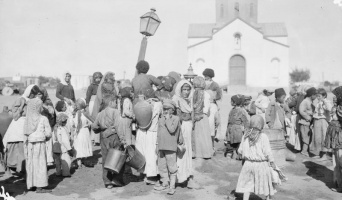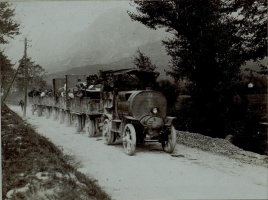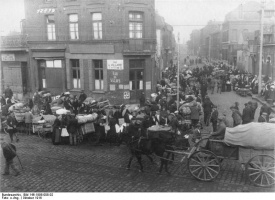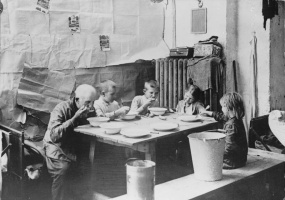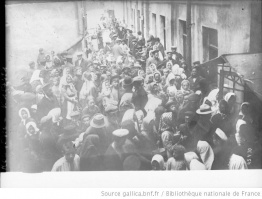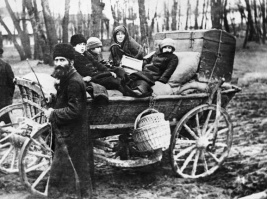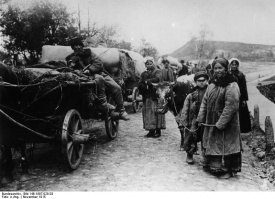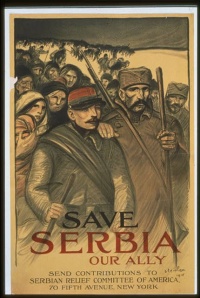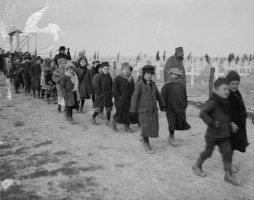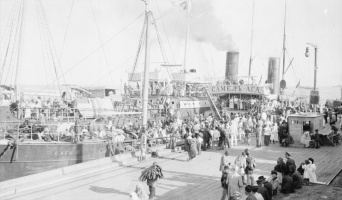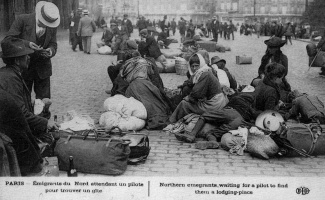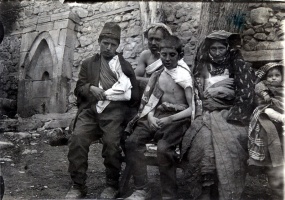Introduction↑
The issue of forced resettlement during the First World War has been given considerable academic attention elsewhere. This article considers the overall scale of population displacement in different locations, and the reception that Europe’s refugees encountered in the destinations they reached.[1] The ramifications of the refugee crisis were considerable and raised multiple questions. Given the large number of civilians who were "out of place", what form should organised relief take and how would it be resourced? This apparently prosaic question had profound implications for the conduct of politics at the local, national and international level. How far should central and local government be responsible for managing refugee relief or should responsibility be devolved on to voluntary agencies, including national and diasporic organisations? What impact would the presence of large numbers of refugees have on social and economic life in the host community? What about the depiction of refugees – were they regarded simply as unfortunate "victims of war"? Was displacement portrayed as a rather unworthy wish for self-preservation in the midst of a national crisis? Might it be explained as the result of the actions taken by the selfsame state to which refugees belonged?
During the First World War the refugee emerged as a liminal figure who threatened social stability partly by virtue of the sheer number of displaced persons, but also because the refugee was difficult to accommodate within conventional classification such as assigned people to a specific social class. Other kinds of disorder were also at stake. The crisis caught everyone by surprise and limited possibilities for political action that might contribute to further upheaval. The social upheaval did not end with the cessation of hostilities.
Historians have been slow to address the significance of wartime population displacement. Recent treatments of the subject have resurrected contemporary accounts in newspapers and in the archival record in order to paint a picture of enormous social upheaval as well as humanitarian intervention.[2] Several important studies have begun to redress the imbalance in the historiography of the First World War. The article taps this enlarged seam of knowledge. It concludes by locating the wartime experience of refugees and relief work in a broader context.
The Size and Destination of the Refugee Population↑
The magnitude of the wartime refugee crisis is difficult to establish with precision. It was characterised by multiple flows of human beings, and therefore an imaginary census at a given point in time would underestimate the real total of those who were displaced. Nevertheless, data from different countries suggest that at least 10 million people were displaced either internally or as a result of fleeing across an international frontier. The circumstances that compelled people to flee have been discussed in the present author’s article on “Resettlement”. Here the focus is on numbers and destinations in different theatres of war.
Upwards of 400,000 refugees fled from Belgium to Holland in the first three months following the outbreak of war. This was only the beginning of an enormous upheaval. An estimated 200,000 Belgian refugees arrived in France in the aftermath of the German invasion. Around 160,000 refugees remained on UK registers at the end of 1916, the number dropping only slightly before the war ended. According to the Ministry of the Interior, the total number of French refugees who were internally displaced reached 150,000 by the end of August 1914. By 1 January 1915 the number exceeded 500,000. After a large increase in 1915, when the total rose from 560,000 to 910,000, the growth rate subsided. During 1918 the momentum increased strongly following the German advance towards Amiens and then Champagne. The number of refugees rose rapidly from 1.32 million in February to 1.82 million in July, an increase of 500,000 in five months. The highest number was reached in September 1918, with 1.85 million refugees. The French government made no preparations for refugees before the outbreak of war. When Germany invaded, the authorities sought to disperse Belgian and French refugees to the interior of France in order to avoid overcrowding areas near to the front. Refugees themselves wished to stay as close as possible to their homes in the hope that they could return before too long. In the UK the British authorities directed Belgian refugees to the big cities such as London, Manchester, Birmingham, Bradford, and Hull, where they obtained accommodation in hostels and boarding houses, and where jobs were more easily found.[3]
Around 200,000 Jewish refugees fled Galicia and Bukovina in the first year of fighting (this figure does not include those who were either resettled within the region or dispatched to the Russian interior). They settled in Vienna and parts of Bohemia and Moravia. According to the Austrian Ministry of the Interior, by the end of 1915 some 386,000 refugees were living in Austria, two-fifths of them Jews. Others scraped by on Hungarian territory, some of them in designated refugee camps.[4]
War between the Habsburg Empire and Italy produced severe demographic turbulence. In the first phase of the war, around 40,000 refugees of Italian extraction sought exile in Italy rather than remaining under Austrian rule. However, the greatest catastrophe occurred in November 1917 following the defeat of Italian forces at Caporetto, which resulted in some 400,000 Italian civilians from the north of the country fleeing to the south.
As a result of Habsburg aggression against Serb civilians, small towns in the Serbian rear, hitherto comprising a few thousand inhabitants, increased in size by a factor of ten or more: for example, the population of the provincial town of Prizren swelled from 20,000 to 150,000 in a matter of days. Worse was to come a year later, when a combined Austrian and Bulgarian intervention, backed by Germany, led to the capture of much of the country. The remaining Serbian forces retreated across Kosovo towards the Adriatic coast where en route they were attacked by Albanian guerrillas. Up to half a million civilians followed the fleeing Serbian army to avoid the anticipated consequences of Bulgarian and Habsburg occupation. The entry of the Bulgarian army into northern Serbia in 1916 prompted a mass flight of civilians to the south. In a now familiar pattern, the property belonging to Greek residents of Macedonia, who fled from the Bulgarian occupation, was seized. This catastrophic displacement of soldiers and civilians directly affected one-third of Serbia’s pre-war population.[5]
The Russian Empire’s western borderlands were transformed into a cauldron of confusion following the defeat of the Tsarist army at the hands of Germany and Austria-Hungary in the spring and early summer of 1915. Refugees crowded into provinces adjacent to the front in the hope of being able to return to their homes within a matter of days or weeks. These hopes soon evaporated. Following the retreat of Russian forces from Galicia, tens of thousands of civilians fled to L’vov and adjacent towns. Many travelled spontaneously on foot without necessarily having a destination in mind. Local authorities also directed refugees to specific destinations by rail or on the waterways. Towns and cities were transformed as a result. By the middle of 1916, more than one in ten inhabitants in some of Russia’s largest towns were refugees; in Samara they made up almost 30 percent, whilst in Ekaterinoslav and Pskov refugees reached around one quarter of the total. Municipal authorities lost no time in trying to evacuate refugees to other parts of the empire. Initial sympathy and hospitality rapidly evaporated as it became apparent that refugees had no money to pay for accommodation or food. In some places, “there were fears of disorders and riots.”[6] Plenty of opportunities presented themselves to people who wished to exploit the vulnerability of refugees. In Russia, as elsewhere, all manner of dread was projected on to displaced persons.[7]
Abrupt physical displacement entailed profound social and political consequences for the Jewish population of imperial Russia. In one sense the war liberated Russian Jewry, by forcing the Tsarist government to recognise that it could no longer continue to sustain the Pale of Settlement. In other words, that it was more important to defeat the real enemy than to maintain administrative controls over the Jewish population of the Russian Empire. As the liberal-minded Minister of Agriculture A. V. Krivoshein (1858-1923) put it: “one cannot fight a war against Germany and against the Jews”. Certainly, Jews continued to suffer all manner of harassment and physical abuse at the hands of the Russian army. Yet once it became clear that their movement could no longer be controlled by government agencies, the Pale of Settlement dissolved itself. In August 1915 the government reluctantly conceded that, “Jewish war sufferers” should be allowed to settle in provincial towns but not in Petrograd or and Moscow. Consistent with pre-war Tsarist policy, Jews were forbidden to settle in villages; all the same, two-fifths of all Jewish refugees moved to areas of the Russian Empire that had previously been closed to them. The consequences were unsettling. The use of Yiddish in public places led some Russians to think that German was being spoken, and this compounded the fear of Jewish cultural difference.[8]
In 1915, Ottoman officials and military commanders turned on entire Armenian communities and forced men, women and children to trek across the desert in the most arduous conditions. Up to 250,000 Armenians evaded the deportations by crossing the Russian border in August 1915, although one in five died en route. More than 105,000 ex-Ottoman Armenians sought refuge in Russian-administered Erevan, quadrupling its size. They were the lucky ones. Women and children who survived the deportations and remained in Armenia were protected or abducted (depending on one’s point of view) by Turkish and Kurdish men.[9]
The Politics and Practice of Emergency Relief in Wartime↑
Against this complex background, involving large numbers of displaced persons, their abrupt departure, and the multiple interpretations given to their displacement, we can begin to trace the efforts made to deal with the consequences of wartime movements. Once urgent needs of food and shelter had been assessed, answers had to be found to the questions that refugees posed. Children were desperate to establish whether their parents were alive or dead, and adults wished to be reunited with children with whom they had lost contact. Refugees sought legal advice about their status and entitlements to relief. Many of them wanted the opportunity to work. Children needed to be found a place to continue their schooling. These basic requirements underpinned the apparatus of relief in all theatres of war.
Inevitably the main burden of supporting refugees, at least to begin with, fell upon the local authorities in the towns and cities into which they gravitated. Municipal budgets were soon stretched to the limit. Local officials sought to rid themselves of this responsibility by getting refugees to move on. They also lost no time in appealing to central governments for additional relief, only to find that the state had other budgetary priorities. This paved the way for private charities and non-governmental organisations to get involved. In Italy, for example, the Ministry of the Interior took charge of relief and resettlement, but faced complaints from local authorities that they had insufficient resources to complete the assigned tasks. Catholic and socialist organisations such as the Opera Bonomelli and Umanitaria, as well as the Red Cross, sought to fill the gap.[10]
Belgian refugees who fled to Holland improvised accommodation by sheltering in makeshift structures such as greenhouses or finding emergency billets on barges and in apartments, hotels and warehouses, in Maastricht, Amsterdam, Groningen and other towns. Later on, local authorities helped to erect cheap bungalows ("maisons démontables"), capable of being quickly dismantled and reassembled elsewhere. In order to appease the resident burghers in these overstretched localities, the Dutch Government decided to house the refugees in camps on the outskirts of towns such as Gouda, Nunspeet and Bergen op Zoom, although the authorities preferred to designate them as "Belgian villages," in order to avoid the negative association with erstwhile "concentration camps" from the South African War (1899-1902). In a strict regime (there were regular roll calls of the camps’ inhabitants) the emphasis was on health and hygiene. Refugees were expected to work hard making toys and household goods.[11]
In France, Belgian refugees received financial and other assistance from the government, on the grounds that they were deserving "victims of war." In addition to state support, refugees received assistance from charitable organisations and from parish priests. No less important were the organisations that refugees themselves created, such as the Committee for Refugees of the Departement du Nord, which played an important role in helping refugees to find accommodation and jobs. In Britain, sympathy for Belgian refugees derived from a belief that they had suffered unspeakable torment at the hands of German troops. "Brave little Belgium" was a term commonly used in the UK, where "King Albert’s Book" allowed British dignitaries to pay "tribute to the Belgian King and people."[12] By 1916, around 2,500 local refugee committees had been established. The secretary of the War Refugees Committee applauded the efforts of local committees and Belgian refugees to find work: “There were people in every country who did not care about work and who would not work if they could help it. But the vast majority of the Belgian refugees were only too ready to take every opportunity of turning their hands to something.”[13] However, concern about the burden on the British taxpayer, the sacrifices made by British conscripts, and anxieties about the "disreputable" sexual conduct of Belgian women, help explain why public sympathy began to diminish by 1916.[14]
In Austria-Hungary conditions were deplorable, particularly for Jewish refugees whose religious and cultural needs were neglected. Poor refugees from the shtetl usually lacked independent means; officials estimated that three-quarters of the total Jewish refugee population from Galicia "lacked means" in 1917.[15] Their presence inflamed existing anti-Semitic sentiment among the non-Jewish townspeople, who all too easily fell into the habit of berating the refugees for their bad manners and contribution to shortages. In Vienna the municipal authorities created a dedicated administration for refugee relief, but it faced an uphill struggle. As elsewhere, the government devolved some responsibility for refugee relief on to Jewish charitable organisations, chief among them the middle-class Israelitische Allianz zu Wien, which built barracks and ensured that refugees were fed kosher food.This organisation also channelled funds from the American Jewish Joint Distribution Committee until the USA entered the war. The philanthropist Sophie Grünfeld (1856-1938) spoke optimistically of the contact between bourgeois Jews and the poor refugees: “Our contact with you has brought us closer and the bearing and dignity with which you bear your tragedy fills us with sincere admiration.”[16] Such optimism was overdrawn; as in Russia, social divisions remained acute. Wealthier Jews made use of their contacts in Vienna, whereas poorer refugees had to make do with substandard accommodation in barns or schools, or else ended up in miserable refugee camps. Jewish charities in Austria and within the diaspora looked further ahead. Workshops were established to encourage young refugee women to learn a suitable trade, or to assist men to become better farmers in anticipation of their return to Galicia or Bukovina. Schools prided themselves on providing instruction and vocational training. In this way displacement became linked to economic improvement in backward parts of the Habsburg Empire. Nevertheless, not everyone was satisfied: Zionists complained that too much attention was being devoted to refugees rather than encouraging emigration to Palestine. An added complication was the vexed question of which refugees were Austria’s responsibility and which were to be assisted by the authorities in Hungary.[17]
Around 140,000 Serbian refugees are thought to have died during the flight to Albania or in exile. Most of them subsequently fled to Salonika, Corsica and France. Serbian schools were established in Nice, Tours, Grenoble and elsewhere. Others found refuge in French colonies, Tunisia, Morocco and Algeria. Some even worked on farms in East Anglia. The less fortunate faced repression and incarceration in Austrian, Hungarian and Bulgarian camps.[18]
Following its occupation of Eastern Anatolia in 1915-16, the Russian army provided extensive aid to Turkish Muslim refugees, partly in order to forestall an outbreak of epidemic disease in nearby areas to the army’s rear.[19] But the greatest humanitarian crisis affected the Armenian survivors of massacre in the Ottoman Empire. Armenian refugees who found their way to neighbouring lands were assisted primarily by Near East Relief (NER), whose statutes of incorporation describe it as a corporation,
Late in 1916 NER arranged for supplies to be sent by the, “US Christmas Ship to the Land of the Christ Child, serving Armenia, Syria and Palestine”.[20] Conditions were appalling. James Barton (1855-1936), the indefatigable director of NER, described refugee camps in Syria, Palestine, Armenia and Persia where refugees ‘had no opportunity for self-support’. However, the efforts of American relief organisations did not escape criticism. An American journalist criticised the luxurious vehicles at NER’s disposal, referring to their use as “joy riding”, and the preponderance of staff who never left Constantinople was also criticised. The organisation gave as good as it got – its secretary angrily told the critic that, “You apparently did not see as much of the refugee camp at Haidar Pasha as you did of the wine tables in Pera Garden …”. He added that, “in, ‘great missionary operations’, nine dollars in ten gets to the field”.[21]
In the Russian Empire, refugees who had survived the journey from areas near the front faced all manner of difficulties. Food, accommodation, sanitary needs, and fresh clothing had to be found. Emergency accommodation was found in railway stations, schools, empty factories, breweries, hotels, bathhouses, army barracks, monasteries, synagogues, theatres, cinemas, cafes, and even prisons. Local authorities, diocesan committees and other associations, provided underwear, shoes, linen, soap and other items. This activity pointed to a political tug-of-war between the government and the public organisations (the Union of Towns and Zemstvos). Nicholas II, Emperor of Russia (1868-1918) appointed two plenipotentiaries for the North-Western and South-Western Fronts, who reported to the Minister of the Interior. A Special Council for Refugees came into being in August 1915, but by including municipal and regional authorities it helped to create a forum for criticising central government incompetence.
The very size and complexion of the multinational refugee population in the Russian Empire, as well as the shortcomings of official relief efforts, paradoxically conferred some advantages on refugees. Patriotic organisations rushed to the scene, including the Society for Assisting War Victims in South Russia, which looked after Ukrainian refugees. In Vilno, refugees were assisted by the Belarusian Society for Assisting War Victims. These initiatives drew on an emerging politics of nationality, in which patriotic elites – Latvian, Polish, Jewish and others – began to conceive of refugees as members of an integral, although dispersed, population, and as potential members of a unified national community. National spokesmen hastily improvised schools, orphanages, clubs, workshops, canteens and barracks, with funds provided by a plethora of national committees. A spokesman for the Polish national committee outlined the implications:
This relief effort should not be idealised however: refugees from Galicia were led to believe that as Slav brothers they would be offered generous assistance, including being settled on the lands forfeited by German colonists. They were quickly disabused of this notion.[22]
The tsarist state tolerated these efforts, partly as a means of lightening the burden on hard-pressed government officials and on the public purse. National committees served another purpose so far as the government was concerned: they represented an acceptable alternative to the public organisations, whose leaders had also asserted a claim to organise refugee relief and resettlement. By the autumn of 1915, contrasts were being drawn between the speed and efficiency of the national committees, and the hesitant manner in which local authorities handled refugee relief. Much more was at stake than providing material assistance. The leader of the Lithuanian Welfare Committee, Martynas Ycas (1885-1941), a Duma deputy and lawyer, boasted that it had "unearthed the buried name of Lithuania and forced even non-Lithuanians to recognise that we ourselves were masters of our country." A conference of Latvian refugee organisations, held in Krasnoiarsk in May 1916, resolved that, “our compatriots have one and the same purpose – to return to Latvia, Siberia being only a provisional place of settlement”. The delegates resolved that "since return to Latvia will be possible only after the war, and since refugees deteriorate [sic] by losing cultural ties, we must pay much more attention to the satisfaction of their cultural and intellectual needs."[23]
The organisation of relief along "national" lines and the appropriation of the refugee for the national cause thus helped to create the possibility for a national politics in circumstances that were hitherto unpropitious. Mass displacement allowed patriotic elites to provide and to construe relief in national terms and to proselytise among a captive audience. This was a genuinely subversive moment in Russian and East European politics.
Refugeedom: The Politics of Cultural Representation↑
The flight and expulsion of civilians was shaped by cultural production, which was in turn connected to domestic politics in a broad sense. For example, to dwell on organised expulsions or evacuations was to draw attention to the pernicious consequences of enemy action (as in "atrocity" stories), but it might equally be a means of advertising uncomfortable facts about the conduct of war by one’s own troops, namely, the way in which defeat meant the abandonment of territory and organising the departure of distraught civilians. That is not all, however. Representing the flight of refugees as spontaneous action on their part is equally disconcerting, since it might imply cowardice, or at the very least a loss of self-control, that manifested itself in panic.
Contemporaries struggled to comprehend the circumstances that led millions of their fellow men and women to leave their homes. It was assumed that many refugees were opportunists who lacked the stomach to resist, and who therefore took the “easy way out.” This lack of understanding led them to conceive refugees as deserters who had failed to demonstrate sufficient fortitude or prowess in the face of the enemy onslaught. At least one British correspondent viewed Serbian refugees in this light, and similar criticisms were levelled at young adult Belgians in France, at least until attempts were made to conscript them in July 1916. Negative views were reinforced by the belief that refugees pushed up the price of food and housing, whilst competing for jobs and driving down wages. Stories surfaced about desperate refugees who stole or damaged farmers’ property, for instance when they fled from Poland to the central provinces of European Russia. Hostility towards refugees found a more acute expression in northern France where they were labelled as ‘les Boches du Nord’ (literally, "Germans of the north"), among whom women attracted especial opprobrium, because they were thought to have slept with German soldiers.[24]
Generally speaking the language used to characterise the refugee movement in Russia and Eastern Europe reinforced the widely-shared sense of calamity. In one formulation, the refugee "problem" was characterised as a "state tragedy"; in another, a “social catastrophe”. Some witnesses believed that the “boundless ocean” of refugees could never properly be navigated. More typically, contemporary observers in the Russian interior used language that was directly reminiscent of a disaster like a river bank being broken. Thus “flood”, “wave”, “deluge”, “avalanche” and volcanic “lava”. The analogy of fertile land being laid waste by “hordes of locusts” was also made. A British newspaper correspondent reported in the autumn 1915 that “fugitives [sic] … are streaming towards the central provinces, like an avalanche”. These metaphors were all the more powerful, given the familiar, widespread and paralysing impact of recurrent natural disasters on the Russian landscape and the national economy. They suggested that refugees belonged to a realm of disorder; they had lost control of their lives. This discourse was readily embraced by the patriotic intelligentsia who reaffirmed the need for each member of the nation to be "rooted." Nor was this language confined to Eastern Europe. Having first described Belgian refugees as mere “sojourners”, British newspapers soon began to describe a refugee "stream" that might yet become a “cataract”. The Times called it “a peaceful invasion”.[25]
Refugees contributed their labour to privately-owned farms and estates in the Russian interior; by the third year of the war refugees made up close on 10 percent of the total labour force in the private farm sector. It helped that refugees included able-bodied workers whose skills were in short supply. A group from Riga that arrived in the Urals after a long journey soon found work as fitters, joiners and blacksmiths. In Kazan, refugees from Minsk worked as bakers, tailors, shoemakers and carpenters, as well as in the local abattoir. Relief organisations applauded the initiative of craftsmen who settled in Smolensk and constructed anatomical models for use by medical students. The Russian rural intelligentsia attributed to refugees the capacity to impart a civilising influences on the backward village. A priest in Simbirsk remarked that, “even in this lonely backwater the refugee movement has brought something new. Refugees who have arrived in the village, no matter how poor they may be, have shown the locals that there are shortcomings in their way of life and daily practices, that it is possible to work a good deal more productively.”[26]
Other kinds of representation also found favour, for example among foreign relief workers who sought to dramatise displacement for audiences in distant locations. The British-based Serbian Relief Fund deployed biblical imagery: "all the time you are reminded of Bible pictures." In Russia too, the plight of the refugee family was juxtaposed with the flight of Mary, Joseph and baby Jesus to Bethlehem. A nurse who served on behalf of the Scottish Women’s Hospital described the arduous trek through the mud south towards Monastir as "Armageddon", or "the Great Retreat, only the first stage of a Calvary which was to endure for several weeks."[27]
Like the Jews, Armenians were regarded by others as an ethnic group that had already been scattered, and whose members were predisposed to be a "wandering" people. Leaders of the Armenian community in the Caucasus themselves alluded to the centuries-old diaspora. They had no obvious "home", being distributed across two empires and at least two continents. Their evident proclivity to migrate and to form dispersed settlements served as an obstacle to official recognition of their plight. The reason for this was quite simple; those who constituted the Armenian diaspora were expected in due course to come to the rescue of those Armenians resident in the Transcaucasus, thereby allowing the burden of relief to be shifted from Petrograd. Reinforcing this idea was the belief that Armenians and Jews shared a common flair for business; their calling was to trade in money and manufactured goods. This perceived commercial guile encouraged the view that both groups survived at the expense of others. Beliefs such as these tended to foster a more jaundiced attitude on the part of the tsarist government towards humanitarian relief.[28]
Nor did relief workers hesitate to draw conclusions about refugees with whom they came into contact. Kathleen Royds (1883-1967), a young relief worker who was sent to Corsica by the Serbian Relief Fund, observed with some distaste that “among refugees is always a large proportion of the less desirable inhabitants of an invaded district”, adding, “families who are undisciplined and disorderly at home are not reformed as by a miracle by the mere fact of fleeing before an enemy as so winning a claim on our pity”. Refugees, in other words, were not always likeable or desirable prospective citizens. Government officials, particularly when confronted by large numbers of refugees at the end of the war, reached similar conclusions.[29]
Attempts to disseminate appeals for assistance meant thinking imaginatively about the most suitable way of generating and sustaining public interest for the plight of refugees. One remarkable attempt to establish the contours of displacement was made in Russia at the end of 1916 by the Tatiana committee, a private charity which brought together members of the Russian aristocratic elite and members of the professions. It proposed a special exhibition designed to inform the Russian public about the living conditions and activities of refugees, who were not all, “beggars, idlers and spongers”. (A similar initiative took place in Vienna under the auspices of the Austrian Ministry of the Interior.) The aim was to address four main themes: First, conditions in Russia’s borderlands before and during the war, including “the destruction of settlements, property and artistic monuments”. Second, the "sorrowful journey" of refugees, including the backgrounds of their displacements, the course of the refugee movement and the assistance given by government and public organisations. Third, the living conditions of refugees in their new homes, including “the work undertaken by refugees and their impact on the local population”. Finally, the restoration of normal life in the regions cleared of enemy occupation. The committee solicited material from refugees, who were encouraged to describe their experiences in their own words, or to provide photographs, drawings, reports, memoirs, stories and belles lettres. Unfortunately the project was overtaken by the February Revolution, but not before Baltic artists contributed paintings and drawings in the expectation that they would eventually be brought together to form part of the collection for new national museums in Latvia and Lithuania. The committee’s initiative retains its relevance nearly a century after: “facts and observations, even if they seem at first to be insignificant and trivial, may prove to be of great interest. The most important thing is that the description be sincere and truthful”.[30]
Aftermaths: Refugees and Relief Workers↑
The Russian Revolution as well as the formation of new nation-states contributed to a post-war refugee crisis whose ramifications were no less serious and which rapidly became internationalised. The "successor states" were hostile to Bolshevism and feared that the repatriation of refugees from Soviet Russia would threaten political and social stability, but many refugees understandably wished to go home. These homelands had undergone fundamental political and economic as well as territorial changes, with consequences that could be deeply troubling. The truncated state of Hungary, for example, offered a chilly prospect for Hungarian refugees who fled from Czechoslovakia. Refugees shuffled hither and thither. Jews from Galicia, who had escaped the fighting between Poland and Ukraine, arrived in newly-minted Czechoslovakia, where they lived in billets. These billets had been vacated by other Jewish refugees, who had been forced out of Galicia in 1914 and 1915, and who had since been moved to the Austrian interior.[31] Other refugees either opted or were forced to remain where they were, because of continued fighting. Economic deprivation imposed additional burdens on displaced and settled populations. Political uncertainty in this enormous contested space only served to multiply these dilemmas and difficulties.
Likewise repatriation took place in a variety of contexts. Grandiose plans drawn up in the UK to resettle Belgian refugees in Chile and South Africa came to naught, because the Belgian authorities insisted that refugees should contribute to national reconstruction in Belgium after the war. Most of the 140,000 Belgian refugees in the UK at the Armistice had returned by the end of 1919. The situation elsewhere was much more complicated. Serbian refugees returned home with the assistance of the Serbian Relief Fund and Quaker relief workers, who managed orphanages and hospitals, but reconstruction took many years to complete. In Austria, some Jewish refugees returned to western Galicia when the war came to an end, but they endured frequent pogroms. Others were prevented from returning home by the vicious conflict in the new Polish-Ukrainian borderland. Their villages had, in any case, been destroyed. Some refugees (although not Jews) succeeded in enrolling in university and gaining citizenship in the new Austrian state.[32]
Between May and November 1918, around 400,000 refugees left Russia for territory that remained under German occupation. The desperate economic situation on Bolshevik-held territory was sufficient to prompt them to take this step. Others adopted a wait-and-see policy. The Russian Civil War and the war between Soviet Russia and Poland complicated the picture still further. The cessation of hostilities in 1921 made it possible for around 1.3 million Poles, who had been uprooted since 1915, to return to their homes. Their motives are encapsulated in the following quote by a group of Polish teachers who complained in 1919 of their desperate material plight, but added that their wish to return to Poland was prompted by,
Having failed to overthrow the new regime, the Bolsheviks’ opponents fled Russia. Most never returned, settling instead in "temporary" refugee camps in Turkey, Bulgaria, Yugoslavia and Greece. By 1922, more than a quarter of all Russian refugees had settled in Germany, 360,000 in Berlin alone. One-fifth lived in Poland, and most of the remainder lived in the Balkan states, France and China. Thousands of refugees were admitted to Czechoslovakia, which expected them to return in due course to a Russia free from Bolshevism. Mutual disillusionment soon set in: Cossack refugees especially felt that they were being exploited by local farmers. Other Russians ended up in the Belgian Congo and Tunisia, where they fantasised about reviving an aristocratic life. The League of Nations invited the famous Polar explorer Fridtjof Nansen (1861-1930) to organise the return of refugees, or to arrange for, “their allocation to the various countries which might be able to receive them and to find means of work for them”. Initially, he entertained hopes of assisting Russian refugees to return from overcrowded places such as Varna and Constantinople, so that they might contribute to Russia’s economic reconstruction. Pro-communist organisations in the west encouraged repatriation, but few refugees took the bait, and Nansen eventually abandoned the idea.[34]
Although Armenian refugees were scattered far and wide, many of them found homes in the fledgling Soviet republic of Armenia. Their plight continued to attract international attention, including from Nansen, who praised the actions of the newly-created Soviet Republic of Armenia, and urged the need for international investment to develop Armenian agriculture. In July 1918, Secretary of State Robert Lansing (1864-1928) wrote to the American Committee for Armenian Relief, urging it to authorise expenditure, “to colonise Armenian refugees dispelled [sic] from Caucasus. Fifty thousand said to be on the way. Advise that they be settled either in Siberia or America. Need great. Must act quickly”. NER sent around 1,000 American relief workers to the region. The spokesman for NER concluded: “A nation has been saved!”. He might have added that the refugee crisis increased the size of the Armenian diaspora in the Middle East as well as in North America, so this was a dispersed “nation”.[35]
The refugee crisis provided opportunities for nurses and other professionals to carry out important relief work. Some of the nurses who were attached to the Scottish Women’s Hospitals and American Women’s Hospitals remained in the field. AWH nurses were employed in Macedonia until the 1930s, for example. Quaker relief workers stayed on in Russia and Poland to assist with famine and typhus relief. Edith Pye (1871-1965) and Hilda Clark (1881-1955),a midwife and obstetrician, respectively, established the Friends War Victims Relief Committee in France in 1914. The worked with refugees in northern France and Haute Savoie, and subsequently moved to Vienna to assist malnourished children. Clark then devoted herself to various relief and reconstruction projects in Poland, Greece, Serbia, Bulgaria and Turkey. Both women also assisted child refugees from Spain after 1936. Likewise Francesca Wilson (1888-1981) travelled from France to Corsica, (to assist Serbian refugees) and Yugoslavia, before joining Pye and Clark in Vienna. She too became involved in relief work in Spain. Impressive careers were thus forged in the crucible of the First World War.[36]
Conclusion↑
The mass movement of civilians during the First World War directly affected millions of men, women and children – refugees and non-refugees alike – but also affected the conduct of belligerent states, civic organisations and diasporic groups in far-flung locations. The burden of assistance posed enormous challenges on state budgets, and this afforded opportunities for non-governmental organisations to fill the resulting gap in provision. In the Russian Empire, the consequences were explosive, creating an opportunity for public organisations to demonstrate their capacity vis-à-vis the government bureaucracy, and also providing an opportunity for national committees to flourish in a way that would have been unthinkable before the war. The outcome was to create a kind of proto-state and thus to anticipate the formation of new nation-states after the war.[37]
The refugee population became a cultural construct. Refugees were not only counted, clothed, fed, given medical assistance, accommodated, educated and (where possible) reunited with family members, they were also described for a perplexed public.This public needed to be prompted into gestures of goodwill, or to be persuaded that professionals and bureaucrats had control over such matters as refugee overcrowding, typhus, crime and public order. Often refugees were portrayed as a security threat, or potential purveyors of Bolshevik doctrine, especially in new states such as Poland, Lithuania and Czechoslovakia. The depiction of refugees during and after the First World War as vectors of infectious disease and as subversive elements anticipated attitudes that became familiar in later 20th century discourse.
To be labelled as a refugee had demeaning consequences, stripping away attributes of social distinction and class to leave oneself exposed to a sense of pure deprivation. The consequences of this silencing are eerily familiar to a modern reader. A Belgian refugee spoke from the heart when he summed up his feelings: “One was always a refugee – that’s the name one was given, a sort of nickname (sobriquet). One was left with nothing, ruined, and that’s how people carried on talking about ‘the refugee’. We weren’t real people any more”. Refugees lamented that “we long to become people once again”. How did refugees react to their circumstances and to the arrangements made on their behalf? It is difficult to answer this question, but there are some indications that displaced people in Russia disliked being categorised as refugees, as emphasised by one refugee who told his readers that, “we are living people (with) the misfortune to have been displaced, but we are human beings all the same”.[38]
Yet if prevailing images tended to homogenise the refugee, creating a single category of difference, nationality offered a means of drawing distinctions between refugees. Refugeedom contributed to the intensification of a sense of national identity, not because one ethnic group alone had been singled out – after all, displacement affected more than one nationality – but because it created the prospect that the "nation" might be permanently displaced, uprooted and scattered. Tormented yet valiant Belgian refugees, whether they spoke French or Flemish, came to stand for the country as a whole, and could trade on their corresponding political value. Italian subjects of the Habsburg Empire were deported by the Austro-Hungarian army and placed in internment camps, but they became a ready-made audience for patriotic Italians to disseminate nationalist propaganda. Serbian refugees symbolised the travails of an entire nation waiting for deliverance from enemy occupation. In Russia, newly-minted national organisations claimed the refugee for themselves, in advance of the dissolution of the Russian Empire. Refugees had a responsibility to the nation, which in turn would not shirk its responsibilities to the refugee. Refugees "belonged" somewhere after all.
Peter Gatrell, University of Manchester[39]
Section Editors: Michael Neiberg; Sophie De Schaepdrijver
Notes
- ↑ See Gatrell, Peter: Resettlement, in 1914-1918 Online Encyclopedia Project.
- ↑ Gatrell, Peter: “World wars and population displacement in Europe in the twentieth century”, in Contemporary European History 16/4 (2007), pp. 415-426.
- ↑ Amara, Michaël: Des Belges à l'épreuve de l'Exil. Les réfugiés de la Première Guerre mondiale, France, Grand-Bretagne, Pays-Bas, Brussels 2008; Nivet, Philippe: Les réfugiés français de la Grande Guerre, 1914-1920. Les ‘boches du nord’, Paris 2004.
- ↑ Rozenblit, Marsha: Reconstructing a National Identity. The Jews of Habsburg Austria during World War One, New York 2001, p. 66; Rechter, David: Galicia in Vienna. Jewish refugees in the First World War, Austrian History Yearbook 28, Austria (1997), pp. 113-130; Hoffmann-Holter, Beatrix: Abreisendmachung. Jüdische Kriegsflüchtlinge in Wien, 1914-1923, Vienna 1995.
- ↑ Opfer, Björn: Im Schatten des Krieges. Besatzung oder Anschluss - Befreiung oder Unterdrückung? Eine komparative Untersuchung über die bulgarische Herrschaft in Vardar-Makedonien, 1915-1918 und 1941-1944, Münster 2005, pp. 115, 120.
- ↑ Polner, Tikhon: Russian Local Government during the War and the Union of Zemstvos, New Haven 1930, p. 175.
- ↑ Gatrell, Peter: A Whole Empire Walking. Refugees in Russia during World War 1, Bloomington 1999; Korzeniowski, Mariusz/Mąndzik, Marek/Tarasiuk, Dariusz: Tułaczy los. uchodźcy polscy w imperium rosyjskim w latach pierwszej wojny światowej, Lublin 2007; Zhvanko, Lyubov M.: Bizhentsi pershoi svitovoi viini. ukrains’kii vimir, 1914-1918 rr. [The Refugees of the First World War: The Ukrainian Reality (1914-1918)], Khar’kov 2012; Samatyia, Vadim: Problema bezhentsev v Belarusi v gody pervoi mirovoi voiny, in Belorusskii zhurnal mezhdunarodnogo prava imezhdunarodnykh otnoshenii 2 (2003), online: http://elib.bsu.by/handle/123456789/31736; Tumanova, Anastasia: The public and the organisation of aid to refugees during World War 1. institutional and legal aspects, Russian Studies in History 51/3 (2012), pp. 81-107.
- ↑ Gatrell, A Whole Empire Walking 1999, pp. 146-147.
- ↑ For an up-to-date guide, see Suny, Ronald Grigor/Göçek, Fatma Müge/Naimark, Norman (eds.): A Question of Genocide, 1915. Armenians and Turks at the End of the Ottoman Empire, New York 2011.
- ↑ Ermacora, Matteo: Assistance and surveillance. War refugees in Italy, 1914-1918, Contemporary European History 16/4 (2007), pp. 445-460.
- ↑ Fry, Ruth: A Quaker Adventure. the Story of Nine Years’ Relief and Reconstruction, London 1926, pp. 103-115.; Roodt, Evelyn de: Oorlogsgasten. Vluchtelingen en krijgsgevangenen in Nederland tidjens de Eerste Wereldoorlog, Zaltbommel 2000, pp. 159, 173-81, 192-4.
- ↑ King Albert’s Book: a tribute to the Belgian King and people, London 1914.
- ↑ de Jastrzebski, T.: "The register of Belgian refugees," Journal of the Royal Statistical Society, 79/ 2 (1916), p. 156.
- ↑ Cahalan, Peter: Belgian Refugee Relief in England during the Great War, New York 1982, pp. 13, 27-30, 170-77; Purseigle, Pierre: A wave on to our shores. the exile and resettlement of refugees from the Western Front, 1914-1918, in Contemporary European History 16/4 (2007), pp. 427-444.
- ↑ Rozenblit, Marsha: Reconstructing a National Identity: The Jews of Habsburg Austria during World War I, New York 2001, p. 66.
- ↑ Rozenblit, Reconstructing a National Identity 2001, p. 75.
- ↑ Mentzel, Walter: Kriegsflüchtlinge und die Flüchtlingspolitik in Österreich-Ungarn während des Ersten Weltkrieges, unpublished PhD dissertation, Vienna 1997, pp. 29-34; Rozenblit, Reconstructing a National Identity 2001, pp. 59, 66-69, 75, 193.; Klein-Pejšová, Rebekah: Beyond the ‘infamous concentration camps of the old monarchy. Jewish Refugee Policy from Wartime Austria-Hungary to Interwar Czechoslovakia, Austrian History Yearbook 45 (2014), pp. 150-166.
- ↑ Yovanovitch, Dragolioub: Les effets économiques et sociaux de la guerre en Serbie, Paris 1930, pp. 41-9, 50-56, 304.; Mitrović, Andrej: Serbia’s Great War, 1914-1918, London 2007, pp. 151-154, 222-223, 229-230.
- ↑ Holquist, Peter: The politics and practice of the Russian occupation of Armenia, 1915-February 1917, in Suny/Göçek/Naimark (eds.), A Question of Genocide 2011, pp. 151-74, at p. 168.
- ↑ Near East Relief Committee Records, Burke Library Archives (Columbia University Libraries, at Union Theological Seminary, New York), MRL2, Series 1, Box 2, Folder 1. These records contain publicity and fund-raising materials, including an instruction leaflet, ‘The call of the dying and destitute Armenians and Syrians to the Sunday schools of America’, containing basic facts and emphasising to American children ‘the opportunity to save life’; ‘the opportunity to develop character through service’; and teaching programmes including discussion of ancient and modern exile, to show ‘the strength of the racial character, the importance and reasonable hope of preserving the boys and girls to useful manhood and womanhood’, Near East Relief Committee Records, MRL2, Series 1, Box 3, Folder 11.
- ↑ Vickery, Charles V., Secretary, NER, to E. Alexander Powell, 9 March 1920, Near East Relief Committee Records,, MRL2, Series 1, Box 1, Folder 3; Box 2, Folder 7.
- ↑ Gatrell, A Whole Empire Walking 1999, 154-157; Bakhturina, A. Iu: Politika rossiiskoi imperii v Vostochnoi Galitsii v gody pervoi mirovoi voiny, Moscow 2000, pp. 189-90.
- ↑ Baron, Nick P./Gatrell, Peter: Population displacement, state-building and social identity in the lands of the former Russian empire, 1917-1923, in Kritika: Explorations in Russian and Eurasian History 4/1 (2003), pp. 51-100, at p. 62.; Ycas is quoted in Gatrell, A Whole Empire Walking 1999, pp. 161.
- ↑ Nivet, Les réfugiés français 2004, pp. 377-85; Amara, Des Belges à l'épreuve de l'Exil 2008, pp. 292-305.
- ↑ Manchester Guardian, Manchester 17 September 1915; Cahalan, Belgian Refugee Relief 1982, p. 4; Gatrell, A Whole Empire Walking 1999, p. 200.
- ↑ Gatrell, A Whole Empire Walking 1999, p. 132.
- ↑ Imperial War Museum, (Flora Scott Collection), 77/15/1; Tatham, M.I.: The great retreat in Serbia in 1915, in C.B. Purdom (ed.): Everyman at War. Sixty Personal Narratives of the War, London 1930, pp. 374-179.
- ↑ Gatrell, A Whole Empire Walking 1999, pp. 150-154.
- ↑ Imperial War Museum, (Undated entry [January 1916?], Papers of Miss Kathleen E. Royds), KER6.
- ↑ Gatrell, A Whole Empire Walking 1999, pp. 94-95; Thorpe, Julie: Displacing empire. refugee welfare, national activism and state legitimacy in Austria-Hungary in the First World War, in Panayi, Panikos/Virdee, Pippa (eds.): Refugees and the End of Empire. Imperial Collapse and Forced Migration in the Twentieth Century, Houndmills 2011, pp. 102-126.
- ↑ Klein-Pejsova, Beyond the "infamous concentration camps" 2014.
- ↑ Cahalan, Belgian Refugee Relief 1982, pp. 444-448; Rozenblit, Reconstructing a National Identity 2001, p. 136; Mentzel, Kriegsflüchtlinge 1997, pp. 37-38.
- ↑ Quoted in Baron/Gatrell, Population displacement 2003, p. 66.
- ↑ Long, Katy: Early repatriation policy. Russian refugee return, 1922–1924, in Journal of Refugee Studies 22/2 (2009), pp. 133–154; Gousseff, Catherine: L’exil russe: la fabrique du réfugié apatride, 1920–1939, Paris 2008.
- ↑ Dodge, Cleveland/Swift, Charles 23 November 1920, (Near East Relief Committee Records, MRL2, Series 2, Box 7, Folder 1; Lansing, Robert: Telegram to the American Committee for Armenian Relief, 6 July 1918, (Near East Relief Committee Records), MRL2, Series 1, Box 3, Folder 11.; Lovejoy, Esther Pohl: Certain Samaritans, New York 1927.; Skran, Claudena: Refugees in Inter-War Europe. the Emergence of a Regime, Oxford 1995, pp. 170-7, 180; Watenpaugh, Keith David: The League of Nations rescue of Armenian genocide survivors and the making of modern humanitarianism, 1920-1927, in American Historical Review 115/5 (2010), pp. 1315-39.
- ↑ Oldfield, Sybil: Doers of the World. British Women Humanitarians, 1900-1950, London 2006, pp. 44-46.
- ↑ Baron, Nick P./Gatrell, Peter (eds.), Homelands. War, Population and Statehood in the Former Russian Empire, 1918-1924, London 2004; Zolberg, Aristide: The formation of new states as a refugee-generating process, in Annals of the American Academy of Political and Social Science, pp. 467, 1983, 282-96.
- ↑ De Schaepdrijver, Sophie: La Belgique et la première guerre mondiale, Frankfurt 2004, pp. 104-105; Gatrell, A Whole Empire Walking 1999, pp. 73-97.
- ↑ I am grateful to Rebekah Klein-Pejšová and Liubov Zhvanko for allowing me to consult their work prior to publication.
Selected Bibliography
- Amara, Michaël: Des Belges à l'épreuve de l'Exil. Les réfugiés de la Première Guerre mondiale. France, Grande-Bretagne, Pays-Bas, 1914-1918, Brussels 2008: Éditions de l'Université de Bruxelles.
- Baron, Nick / Gatrell, Peter (eds.): Homelands. War, population and statehood in Eastern Europe and Russia, 1918-1924, London 2004: Anthem Press.
- Ermacora, Matteo: Assistance and surveillance. War refugees in Italy, 1914-1918, in: Contemporary European History 16/4, 2007, pp. 445-459.
- Gatrell, Peter: A whole empire walking. Refugees in Russia during World War I, Bloomington 2011: Indiana University Press.
- Nivet, Philippe: Les réfugiés français de la Grande Guerre (1914-1920). Les 'boches du nord', Paris 2004: Economica; Institut de stratégie comparée.
- Roodt, Evelyn de: Oorlogsgasten. Vluchtelingen en krijgsgevangenen in Nederland tijdens de Eerste Wereldoorlog (War guests. Refugees and prisoners of war in the Netherlands during the First World War), Zaltbommel 2000: Europese Bibliotheek.
- Thorpe, Julie: Displacing empire. Refugee welfare, national activism and state legitimacy in Austria-Hungary in the First World War, in: Panayi, Panikos / Virdee, Pippa (eds.): Refugees and the end of empire. Imperial collapse and forced migration in the twentieth century, Houndmills; New York 2011: Palgrave Macmillan, pp. 102-126.
- Thurstan, Violetta: The people who run. Being the tragedy of the refugees in Russia, London; New York 1916.
- Zhvanko, Liubov: Bizhentsi pershoi svitovoi viini. Ukrains’kii vimir, 1914-1918 rr. (The refugees of the First World War. The Ukrainian reality), Kharkiv 2012: Virovetsʹ A.P. 'Apostrof'.






